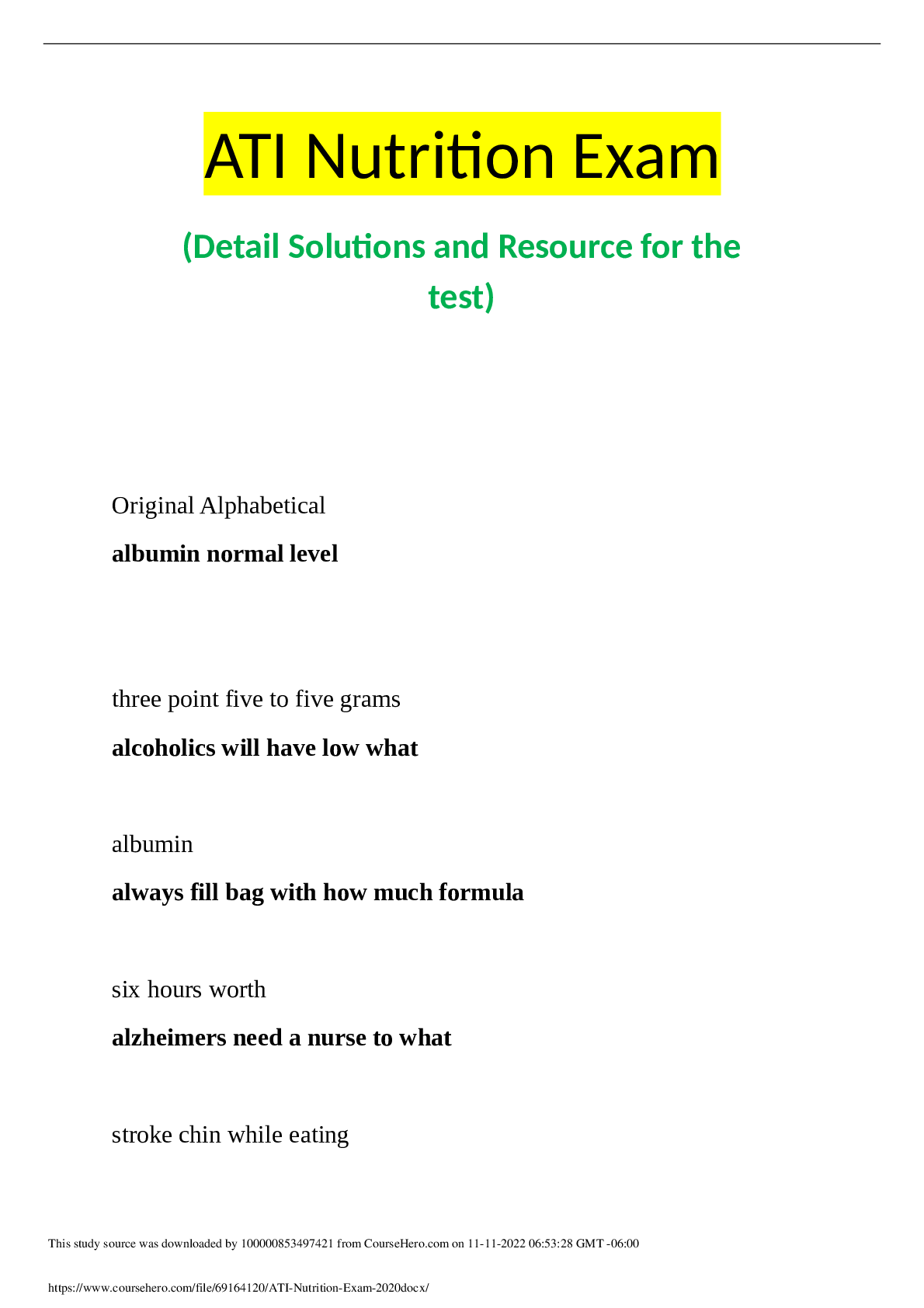Nutrition ATI Proctor Focus Review
Document Content and Description Below
Nutrition ATI Proctor Focus Review 2019 1) Dysphagia Diet – Nursing Actions a. Place pt. in high fowler’s or upright position b. High risk for aspiration c. Give pt. oral care prior to eating ... d. Allow adequate time to eat/chew and use assistive devices e. Give/encourage small bites 2) Water intoxication/excess (Hyponatremia) a. Risk factors i. Compromised regulatory system - Heart failure, kidney disease, cirrhosis ii. Overdose of fluids – IV, oral, enteral iii. Burns iv. Prolonged use of corticosteroids v. Severe stress vi. Hyperaldosteronism - endocrine disorder that involves one or both of your adrenal glands creating too much of a hormone called aldosterone. This causes your body to lose too much potassium and retain too much sodium, which increases water retention, blood volume, and blood pressure. b. S&S i. Tachycardia, bounding pulse, Hypertension, Tachypnea, *Increased central venous pressure ii. Crackles, Cough, Dyspnea iii. Liver enlargement iv. Seizures, Weakness, Visual changes, Altered LOC, Paresthesia c. Lab Test i. Decreased – Hct & Hgb, BUN, urine sodium & specific gravity, blood osmolarity 3) Fluid volume deficit - Dehydration/Hypovolemia a. Risk factors i. Excessive GI loss – vomiting, diarrhea, nasogastric suctioning ii. Excessive skin loss – diaphoresis (sweating) without sodium & water replacement iii. Excessive renal system loss – diuretic therapy, kidney disease, adrenal insufficiency iv. Third spacing burns v. Hemorrhage (blood loss) or plasma loss vi. Altered intake – nausea, anorexia, impaired swallowing, confusion, nothing by mouth (NPO) b. Causes :00 i. Hyperventilation or excessive perspiration without water treatment ii. Prolonged fever iii. DKA – Diabetic ketoacidosis iv. Insufficient water intake v. Diabetes insipidus vi. Osmotic diuresis vii. Excessive salt intake, salt tablets, hypertonic IV fluids c. S&S i. Hyperthermia, tachycardia, thread pulse, hypotension, orthostatic hypotension, decreased central venous pressure, tachypnea, hypoxia ii. Dizziness, syncope, confusion, weakness, fatigue iii. Thirst, dry furrowed tongue, nausea, vomiting, anorexia, acute weight loss iv. Oliguria v. Diminished capillary refill, cool clammy skin, diaphoresis, sunken eyeballs, flattened neck veins, skin turgor, hyperthermia, seizures d. Lab test i. Increased – HCT, BUN, urine specific gravity, sodium (hypernatremia), blood osmolality 4) Atorvastatin – priority assessment a. Negative nitrogen balance causes i. Use of alcohol, caffeine, nicotine b. S&S i. Hepatotoxicity 1. Avoid alcohol 2. Obtain LFTs ii. Myopathy 1. Obtain creatine kinase (CK) level 2. Can progress to myositis or rhabdomyolysis c. Nursing Interventions i. Give with evening meal ii. 5) Foods with high water content a. Lettuce, gelatin, soup, melons b. 2.7 L for females & 3.7 for males 6) Vegan deficiencies a. Iron b. Zinc c. Calcium d. Vitamin D e. Omega-3 fatty acids f. Vit. B12 7) Osteoporosis prevention food sources - calcium [Show More]
Last updated: 2 years ago
Preview 1 out of 4 pages

Buy this document to get the full access instantly
Instant Download Access after purchase
Buy NowInstant download
We Accept:

Reviews( 0 )
$9.00
Can't find what you want? Try our AI powered Search
Document information
Connected school, study & course
About the document
Uploaded On
Jun 07, 2021
Number of pages
4
Written in
Additional information
This document has been written for:
Uploaded
Jun 07, 2021
Downloads
0
Views
89




 (2).png)


.png)



 (1).png)

